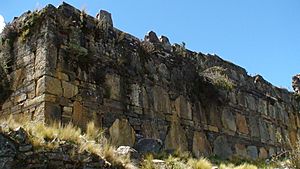Yaynu facts for kids

Stonework at Yaynu
|
|
| Location | Peru, Ancash Region, Pomabamba Province |
|---|---|
| Coordinates | 8°53′12″S 77°27′22″W / 8.88667°S 77.45611°W |
| Height | 4,000 metres (13,123 ft) |
Yaynu (also spelled Yaino or Yayno) is an ancient site in Peru. It is found in the Ancash Region, in the Pomabamba Province. This amazing place is a settlement built on top of a hill.
Experts believe Yaynu is the most important example of the Recuay culture in the Ancash Region. In 2004, it was officially named a National Cultural Heritage site. This means it's a very special place that needs to be protected.
The stone buildings of Yaynu are about 17 kilometers (10.5 miles) south of Pomabamba. They sit high up on a mountain slope, more than 4,000 meters (13,123 feet) above sea level.
What is Yaynu?
Yaynu is the biggest known site from the Recuay culture. You can think of it as a fortified town built on a hilltop. The main part of the town covers about 25 hectares (62 acres). If you include all the defenses, animal pens, and terraced fields, the area is over 105 hectares (259 acres).
The center of the town is surrounded by strong walls and long ditches. The buildings are made of stone and are built very close together.
History of Yaynu
Studies and digs at Yaynu show that people lived here mainly between 400 AD and 800 AD. These people belonged to the Recuay culture. Yaynu was like the main hub for smaller farming villages nearby.
How Yaynu was Protected
Yaynu had impressive ways to defend itself. It used both natural features of the land and man-made defenses. These defenses worked together to keep outsiders away. They also helped to keep different groups within the town separate from each other.
The strong walls and defenses at Yaynu tell us a lot about how people lived back then. They show that being able to defend themselves was very important. The leaders of the Recuay culture built these big structures. This helped them show their power and identity. They built upon older traditions of living on hilltops and defending their homes.
See also

- In Spanish: Fortaleza de Yaino para niños

